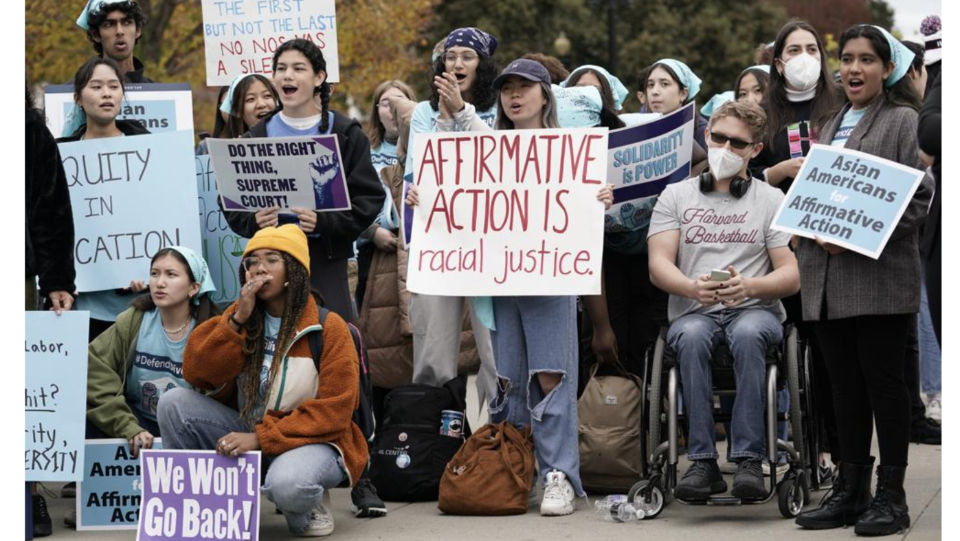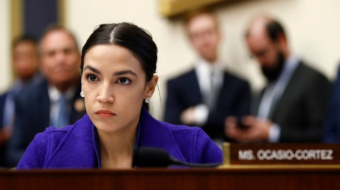
WASHINGTON—When it comes to upholding even a mild form of affirmative action, three big unions—the Teachers (AFT), the National Education Association (NEA), and the Service Employees say “yes”—and the Republican-named Supreme Court justices are apparently saying “no.”
And if five hours of oral argument—and it really was an intense argument this time—before the High Court on Oct. 31 on the issue is any indication, “no” will win.
“Yes” has only three votes among the nine justices—Democratic-named Justices Ketanji Brown Jackson, Elena Kagan, and Sonia Sotomayor. “No” has six: The Republican-named majority of Chief Justice John Roberts and Justices Clarence Thomas, Samuel Alito, Brett Kavanaugh, Amy Coney Barrett, and Neil Gorsuch.
All six were skeptical and/or critical about whether affirmative action programs at Harvard and the University of North Carolina really work and are prepared to trash the whole idea, as demanded by attorney Patrick Strawbridge, representing a so-called Asian group, Students for Fair Admissions”—which included “other interested parties.” Those interested parties include parents and affirmative action foes, unnamed.
The discussion got so heated that at one point Strawbridge stated affirmative action runs counter to the Supreme Court’s famous 1954 Brown v. Board of Education decision outlawing legalized racial segregation in public schools.
“I’ve heard the word ‘diversity’ quite a few times, and I have no idea what it means,” Justice Thomas, who is Black and the court’s longest-serving justice, told North Carolina Solicitor General Ryan Park, who defended UNC’s affirmative action program.
And Chief Justice Roberts told Harvard’s lawyer, “We did fight a civil war to eliminate racial discrimination.
“I think it’s important for you to establish whether or not to grant a credit based on skin color”—a credit which could tip an admissions decision even as one of 40 factors universities use—“is based on a stereotype when you say it brings diversity of viewpoint.” Encouraging diverse viewpoints was a key argument in the union briefs, too.
The session again reinforced the reality that the court majority follows the right-wing agenda, especially as advocated by former Republican Oval Office occupant Donald Trump. Aided and abetted by Senate Republicans, Trump seated Justices Barrett, Gorsuch, and Kavanaugh. Their bloc, with Justices Thomas and Alito, control the court.
Never mind precedents starting in 1978. Never mind data from the University of California system and elsewhere that shows when affirmative action was outlawed, diversity dropped drastically. Never mind that not just unions but businesses and even the military—again—spoke out for affirmative action, as Justice Kagan pointed out.
Never mind that AFT’s brief, though not cited, refuted the Republican-named justices’ suggestion that other methods—such as more financial aid—could achieve the universities’ goals. AFT has provided data showing such substitutes don’t work.
And never mind, as Justice Jackson pointed out, that abolishing affirmative action might only deepen society’s division.
If universities can consider the other 39 characteristics they use when determining whom to admit, but not race, the court’s first Black woman justice said, then there’s “the potential of causing more of an equal protection” of the laws “problem than” abolition of race as an admissions factor is “actually solving.”
But for the GOP judges, ideology comes first.
Even if affirmative action were found acceptable, the conservative justices demand that it come with an “end date,” a time when it would no longer be needed. They said they doubted it really produces the benefits to both colleges and the wider society its supporters, including the three unions, claim.
The three unions—NEA, AFT, and the Service Employees—sided with Harvard and UNC in filing friend-of-the-court briefs. All emphasized the benefits of diversity.
“An impressive body of empirical research has shown that fostering racially diverse classrooms is a fundamental and necessary step in closing racial achievement gaps and promoting productive intergroup relations in society at large,” the joint NEA-SEIU friend of the court brief declared. “Admission to selective institutions results in stronger academic performance for students of color who benefited from affirmative action.”
Citing “empirical research,” SEIU and NEA added affirmative action also helps break down systemic racism, the two unions told the court. It’s especially effective if integration occurs in primary and secondary grades but also has an impact when students of different races mix and mingle in colleges, too. “The impact of integrated schooling is significant and long-lasting.
“Contact with a broad spectrum of different people of other races is more effective in breaking down racist and prejudicial attitudes than contact with just a few individuals of another race, because it forces people to ‘decategorize’ those with whom they are dealing and to treat them as individuals.”
Quoting from the Supreme Court’s affirmative action ruling in the Grutter case in 2003, SEIU and NEA added: A “variety of viewpoints among minority students” helps to break down racial stereotypes, and “non-minority students learn there is no ‘minority viewpoint’ but rather a variety of viewpoints among minority students.” And that “in turn holds tremendous value for our economy, military, and society at large.”
AFT’s brief to the court hit the same points, with some additions.
“Education is the pathway to all manner of professions that are vital to our economy and society, from medicine to engineering and, indeed, careers in education itself,” the union said. And the nation has compelling interests in integration in all fields and at all levels of schooling.
“The proposed blanket ban on any consideration of race in admissions undermines these compelling interests. Because race-conscious admission policies are a patchwork, with some states having banned them outright, it’s possible to examine the results of such bans and to envision a world in which universities nationwide were prohibited from bearing applicants’ race in mind.”
One estimate is that nine states so far have banned considering race during university admissions.
“The results are unsettling, both for students of color and for universities as they pursue their educational missions,” AFT added. “The United States…has enjoyed the gains of educational diversity” only since the 1970s.
Universities, students, and society still need the benefits of the race-conscious admissions programs.”
Keeping those benefits “is a compelling state interest” in fostering a more-just society and nation, AFT stated.
“Even today, unequal access to education persists, with ripple effects that stand in the way of the kind of fair, diverse, and harmonious society the Constitution was designed to foster.”
The justices will issue a ruling in the case on or before June 30, 2023, the end of the current term.












Comments